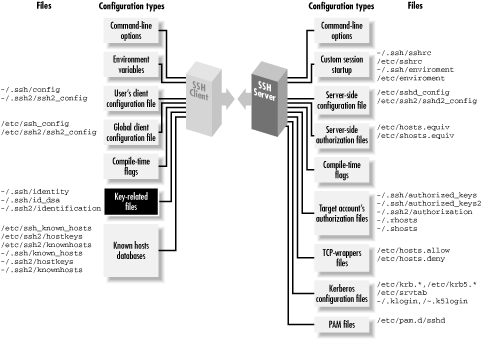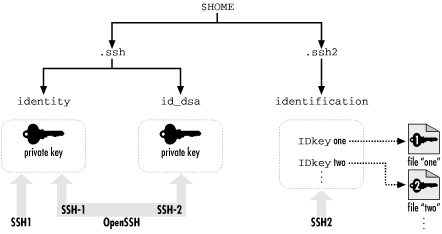Your
SSH private key is a precious thing. When you use public-key
authentication, your key proves your identity to SSH servers.
We've encountered several programs related to keys:
However, we haven't gone into much depth, covering only the
most basic operations with keys. Now it's time to examine these
concepts and programs in detail.
and
the keys that represent them. After that, we thoroughly cover SSH
agents and their many features. Finally, we extol the virtues of
having multiple SSH identities. If you've been getting by with
a single key and only light agent use, we have a lot of cool stuff in
store for you.
summarizes the role of
key management in the overall configuration process.
This chapter is the first in a sequence on advanced SSH for end
users, as opposed to system administrators. Once you've covered
key management in this chapter, we'll take you through client
configuration, server configuration, and forwarding.
6.1. What Is an Identity?
An SSH
identity
is a sequence of bits that says, "I am really me." It is
a mathematical construct that permits an SSH client to prove itself
to an SSH server, so the SSH server will say, "Ah, I see,
it's really you. You hereby are authenticated. Come in."
An identity consists of two parts, called the
private key and
the
public key.
Together, they are known as a
key pair.
The private key represents your identity for outgoing SSH
connections. When you run an SSH client in your account, such as
ssh or
scp, and it requests a
connection with an SSH server, the client uses this private key to
prove your identity to the server.
WARNING:
Private keys must be kept secret. An intruder
with your private key can access your account as easily as you can.
The public key represents your identity for incoming connections to
your account. When an SSH client requests access to your account,
using a private key as proof of identity, the SSH server examines the
corresponding public key. If the keys "match" (according
to a cryptographic test [
Section 3.4.2.2, "Public-key authentication"]), authentication
succeeds and the connection proceeds. Public keys don't need to
be secret; they can't be used to break into an account.
A key pair is typically stored in a pair of files with related
names.
[76] In SSH, the public key filename is formed by adding the
suffix
.pub to the
private key filename. For example, if the file
mykey holds a private key, its corresponding
public key is found in
mykey.pub.
[77]
You may have as many SSH identities as you like. Most SSH-1 and SSH-2
implementations let you specify a
default
identity clients use unless told otherwise. To use an
alternative identity, you must change a setting by command-line
argument, configuration file, or some other configuration tool.
The structure of identity files differs for SSH1, SSH2, and OpenSSH,
so we will explain them separately. Their locations in the filesystem
are shown in
Figure 6-2 (private keys) and
Figure 6-3 (public keys).
Figure 6-2. SSH identity files (private keys) and the programs that use them
Figure 6-3. SSH authorization files (public keys) and the programs that use them
6.1.1. SSH1 Identities
An
SSH1 identity is stored in two files. By default in SSH1, the private
key is stored in the file
identity and the
public key in
identity.pub. This key pair, which
is kept in your
~/.ssh directory, is your
default identity clients use unless told otherwise.
The
.pub file containing your public key has no
function by itself. Before it can be used for authentication, this
public key must be copied into an authorization file on an SSH-1
server machine, such as
~/.ssh/authorized_keys for SSH1 or OpenSSH. Thereafter,
when an SSH-1 client requests a connection to your server account
using a private key as proof of identity, the SSH1 server consults
your
authorized_keys file to find the matching
public key. [
Section 3.4.2.2, "Public-key authentication"]
6.1.2. SSH2 Identities
An
SSH2 key pair, like its SSH1 ancestor, is stored in two files with
the same relationship between their names (i.e., the private key
filename plus
.pub yields the public key
filename). SSH2 key files are often named based on the key's
cryptographic properties. For example, a 1024-bit, DSA-encrypted key
is generated by default in the SSH2 files
id_dsa_1024_a and
id_dsa_1024_a.pub.
Unlike SSH1, however, an SSH2 identity is not a single key but a
collection of keys. When an SSH2 client tries to
authenticate, it may use all keys in the collection. If the first key
fails to authenticate, the SSH2 client automatically tries the
second, and so forth, until it succeeds or fails completely.
To create an identity in SSH2, private keys must be listed in a file
called an
identification file. Your default
identity is stored in
~/.ssh2/identification.[78] Inside the file, private
keys are listed one per line. For public-key authentication, a line
begins with the keyword
IdKey, followed by the name of the private key
file:
# SSH2 identification file
# The following names are relative to ~/.ssh2
IdKey id_dsa_1024_a
IdKey my-other-ssh2-key
# Absolute paths work for SSH2 2.1.0 and later
IdKey /usr/local/etc/third-key
You may recall that SSH2 supports
PGP
key authentication. [
Section 5.5.1.6, "PGP authentication"] The identification
file may also contain PGP-related keywords:
# SSH2 identification file
PgpSecretKeyFile my-file.pgp
IdPgpKeyName my-key-name
Using a separate identification file might seem cumbersome, but it
provides flexibility SSH1 doesn't. As we've said, it
permits an identity to contain multiple keys, any one of which may
authenticate you. Another advantage of the SSH2 system is ease of
deletion. To remove an SSH2 private key from consideration, simply
delete or comment out its line from the identification file. To
accomplish the same task with SSH1, you have to rename the private
key file.
Like SSH1, SSH2 has an authorization file for incoming connections
but with a difference. Instead of containing copies of public keys,
the SSH2 authorization file merely lists the public key files using
the
Key keyword:
# SSH2 authorization file
Key id_dsa_1024_a.pub
Key something-else.pub
This is easier to maintain than SSH1's
authorized_keys file because only one copy of
each public key exists. For SSH1 and OpenSSH, in contrast, there are
separate copies in the
.pub and
authorized_keys files. [
Section 8.2.2, "SSH2 Authorization Files "]
6.1.3. OpenSSH Identities
For
SSH-1 connections, OpenSSH uses exactly the same identity and
authorization files as SSH1. For SSH-2 connections, your default
identity is stored in the file
~/.ssh/id_dsa
(private key) and
~/.ssh/id_dsa.pub (public
key). The SSH-2 authorization file for OpenSSH is
~/.ssh/authorized_keys2, and its format is
similar to that of
~/.ssh/authorized_keys. [
Section 8.2.1, "SSH1 Authorization Files "]








